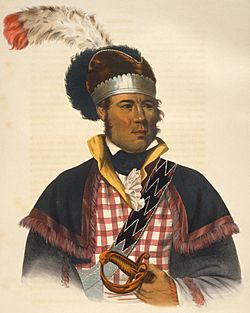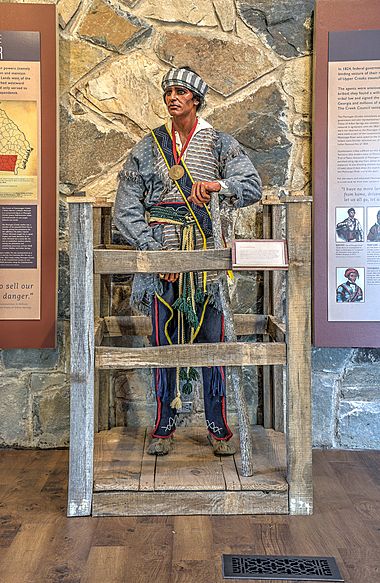William McIntosh facts for kids
Quick facts for kids
William McIntosh
|
|
|---|---|
| Tustunnuggee Hutke | |

William McIntosh, 1838 by Charles Bird King
|
|
| Born |
William
1775 Coweta, Creek Nation (present-day Georgia, U.S.)
|
| Died | April 30, 1825 |
| Cause of death | Execution |
| Resting place | Carroll County, Georgia |
| Spouse(s) | (1) Eliza Hawkins (2) Susanna (3) Peggy |
| Children | Chilly McIntosh, Jane, Rebecca, Delilah, D. N. McIntosh |
| Parent(s) | William McIntosh and Senoya |
| Relatives | Alexander McGillivray, William Weatherford |
William McIntosh (1775 – April 30, 1825), also known as Tustunnuggee Hutke (White Warrior), was an important chief of the Creek Nation. He was a leader in the town of Coweta. He also commanded a special police force.
McIntosh became a successful farmer and ran an inn and a ferry business. Early historians thought his mixed Scottish and European background made him influential. But later historians realized his Creek upbringing and his mother's important Wind Clan were more key to his power. In the Creek system, family lines and property passed through the mother's side.
McIntosh signed a treaty in 1825 that gave away a lot of Creek land to the United States. This went against Creek law. Because of this, the Creek National Council ordered his execution. He was killed by Menawa and a group of Creek "Law Menders" in April 1825.
Many of McIntosh's family members moved to Indian Territory (now Oklahoma) before the forced removals of the 1830s. His sons, Chilly and Daniel, became officers in the Confederate States Army during the American Civil War. His daughter Rebecca became a very wealthy woman in Texas.
Contents
Early Life and Family Connections
Tustunnuggee Hutke (White Warrior) was born in the Lower Creek town of Coweta, in what is now Georgia. His mother, Senoya, was from the important Wind Clan of the Creek Nation. In the Creek culture, children belonged to their mother's clan. This meant William's status came from his mother.
His father was also named William McIntosh, a Scottish-American soldier. His father was a Loyalist during the American Revolutionary War. This means he supported the British. The elder McIntosh worked with the Creek people to get them to help the British.
William McIntosh was known as a good speaker and leader. He became a wealthy farmer who owned many enslaved people. He was important in both Creek and European-American societies. One of his cousins, George Troup, later became the governor of Georgia.
Many Creek chiefs allowed their daughters to marry fur traders. This helped them build strong alliances and trade with Europeans. William McIntosh was related to many other influential Creek chiefs through both his parents. Many of these chiefs were métis, meaning they had Creek mothers and white fathers. Two famous relatives were Alexander McGillivray and William Weatherford. Both became important Creek chiefs and wealthy farmers. Weatherford, however, sided with the traditionalist Red Sticks during the Creek Wars, while McIntosh sided with the Americans.
Family and Relocation
Chief McIntosh had several wives and many children. His first wife was Eliza Hawkins. They had five children: Chilly, Jane, Kate, Sallie, and Louis. Their first son, Chilly McIntosh (1800–1895), was born in Coweta, Georgia.
Later, McIntosh married Susannah Ree. They had four children: Rebecca, Catherine Hettie, Delilah, and Daniel (D.N.). McIntosh also had a third wife named Peggy.
After McIntosh's death in 1825, his wife Eliza, his half-brother Roley, and most of his children moved to "Indian Territory" (Oklahoma). This happened between 1826 and 1830, before the forced removals known as the Trail of Tears.
His daughter Kate stayed behind in Georgia. She married William Cousins, a full-blooded Creek. They later moved to Florida, becoming early pioneers there. In Oklahoma, McIntosh's sons Chilly and Daniel became officers in the Confederate Army during the American Civil War. Chilly became a Colonel.
Career and Influence
Chief McIntosh adopted some parts of European-American culture. He wanted to bring American education to the Creek people. He also used enslaved African Americans on his farms. He helped centralize the Creek National Council over the years. As a successful businessman, he owned over 100 enslaved people and two large farms. He grew cotton and raised animals. He also ran two ferries, an inn, and a tavern.
He used his power to improve a Creek trail. This trail connected the Upper and Lower Creek towns. It ran from Talladega, Alabama, to the Chattahoochee River. He owned two farms: Lockchau Talofau ("Acorn Bluff") in Carroll County and Indian Springs in Butts County. His Acorn Bluff farm was at the end of the McIntosh Road. Here, he ran a ferry across the Chattahoochee River. He also built a hotel at Indian Springs. He hoped to attract more travelers along the improved road. Parts of this route are still called the McIntosh Road.
After the American Revolutionary War, the Creek Nation faced problems. There were debates about adopting European-American culture. The Lower Towns, where most Creeks lived, were closer to white settlers. Many of them started to use English and sent their children to schools. Some Creek leaders became wealthy farmers, buying enslaved people to work on their farms.
Role in the Creek War
Tensions between the Lower Creeks and the traditional Red Sticks (from the Upper Towns) led to the Creek War (1813–1814). McIntosh and the Lower Creeks joined forces with the United States against the Red Sticks. The Red Sticks were allied with the British. Both wanted to stop American expansion in the Southeast.
McIntosh fought with General Andrew Jackson and state militias. He helped win the Battle of Horseshoe Bend in 1814. This battle defeated the Red Sticks and ended the Creek War. After the war, General Jackson made McIntosh a brigadier general in the United States Volunteers.
The Creek people were forced to give up land to the United States in the early 1800s. McIntosh helped with these land deals in 1805, 1814, 1818, and 1821. For his help in the 1821 land deal, American agents gave McIntosh 1,000 acres of land at Indian Springs. They also gave him 640 acres on the Ocmulgee River.
After the wars, more European-American settlers moved into the Southeast. They began to take over Creek lands. Growing cotton became very profitable with the invention of the cotton gin. This led to a high demand for enslaved African Americans.
First Seminole War
Some Creek people, other Native American tribes, and escaped enslaved people moved to Spanish Florida. They formed a new tribe called the Seminole. Enslaved African Americans from Georgia also escaped to Spanish Florida. The Spanish offered them freedom and land if they became Catholic.
After the War of 1812, the British left a fort on the Apalachicola River. Newly freed African Americans took it over. About 300 African-American men, women, and children lived there. Georgia slaveholders and the U.S. Army worried that this fort would encourage their own enslaved people to escape. McIntosh fought with the United States in the First Seminole War. He helped capture the fort.
Forming a Centralized Creek Government
Chief McIntosh worked with chiefs from the Upper and Lower Towns to create a stronger, more central Creek government. They used some ideas from American traditions. They wrote laws in the Code of 1818. These laws protected tribal land and created a police force called the Law Defenders. To protect their remaining lands, the National Council, including McIntosh, made a law in 1824. This law said that giving away communal land was a serious crime.
Treaty of Indian Springs (February 1825)

The United States and Georgia wanted more Native American land. On February 12, 1825, McIntosh and eight other chiefs signed the Treaty of Indian Springs. These chiefs included Samuel and Benjamin Hawkins, who were mixed-race Creek men. Samuel was married to McIntosh's daughter Jane. Benjamin later married his daughter Rebecca.
This treaty gave all remaining Creek land in Georgia and 3,000,000 acres in Alabama to the United States. In return, the Creek Nation would receive $200,000 and yearly payments. McIntosh himself received another $200,000. Historians still debate why McIntosh signed the treaty. Some believe he did it for personal gain. Others think he believed giving up the land was unavoidable.
When the Creek National Council found out, they protested to Washington. But the U.S. Senate had already approved the treaty. Governor George Troup of Georgia, who was McIntosh's cousin, had promised him protection.
Death
The Creek National Council had a law from 1818. It said that giving away communal Creek lands was a crime punishable by death. This was the first time the Council ordered the execution of men for a crime against the entire Nation. The Council chose Chief Menawa to carry out the sentence.
On April 30, 1825, Menawa and a large group of 120-150 Law Menders attacked McIntosh's farm. They set his house on fire. McIntosh was wounded by gunfire and pulled from the burning house. He was then killed.
His burial site and part of his farm are now preserved as the McIntosh Reserve in Carroll County, Georgia. His grave is near a replica of his home in McIntosh Reserve Park.
Members of the National Council, including Menawa, went to Washington to protest the 1825 treaty. The U.S. government later said the 1825 treaty was not valid. They negotiated a new one in 1826, the Treaty of Washington. This new treaty allowed the Creeks to keep about 3 million acres in Alabama. Georgia, however, ignored the new treaty.
Legacy
After William's death, his younger half-brother Roley McIntosh became chief of the Lower Creeks. He served until 1859 and moved with them to Indian Territory in the 1830s.
Led by his son Chilly, McIntosh's family and other Creeks moved to Indian Territory between 1826 and 1830. They settled in what became the Western Creek Nation. His sons Chilly and Daniel McIntosh both served as Confederate officers in the Civil War. They later became Baptist ministers.
His daughter Catherine "Kate" McIntosh and her husband became pioneers in Florida in 1842.
His daughter Rebecca McIntosh married Benjamin Hawkins in 1831. They moved to Texas and started a farm. After Benjamin died, Rebecca married Spire M. Hagerty. By 1860, Rebecca Hagerty was the richest woman in Texas. She owned three large farms totaling 12,800 acres. She was also the only woman in Texas to own over 100 enslaved people at that time.
- The McIntosh Reserve Park was created in Whitesburg, Georgia.
- Chief McIntosh Lake in Georgia is named after him.
- McIntosh High School in Peachtree City, Georgia is named after him.
- In 1921, McIntosh's grave was marked by a stone with a bronze tablet. It was placed by the William McIntosh Chapter of the DAR. The tablet honors him as a "Distinguished and Patriotic Son of Georgia."
- The McIntosh Trail is being considered as a state scenic byway in Georgia. McIntosh had improved this trail to help trade and travel.
Images for kids
-
Exhibit at Indian Springs State Park Museum



